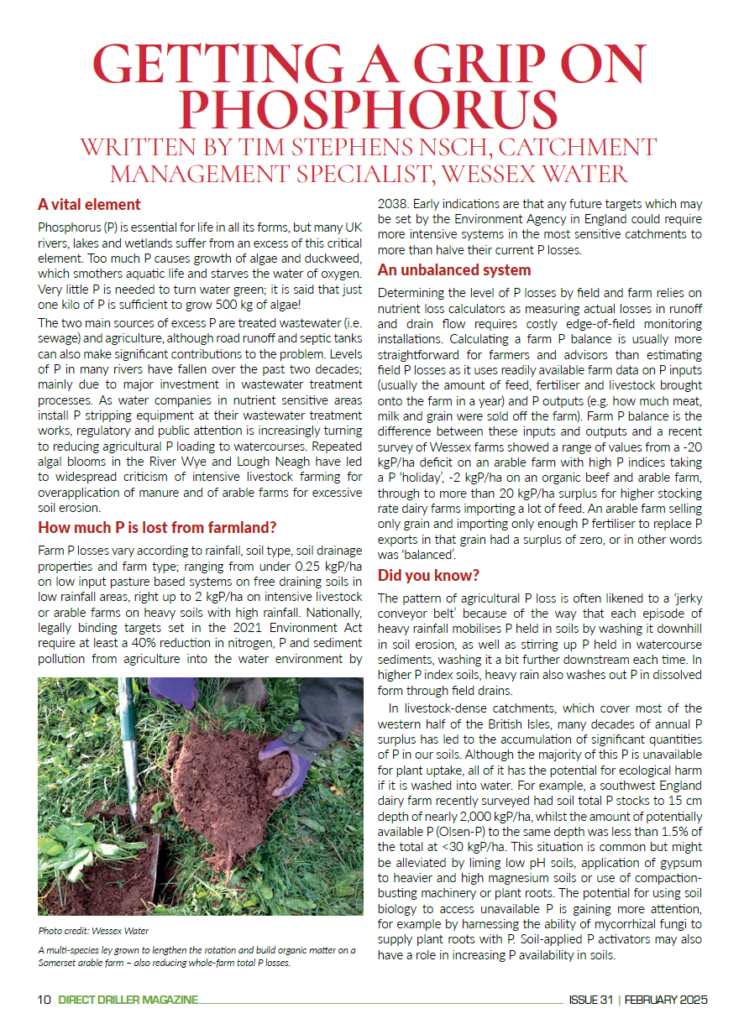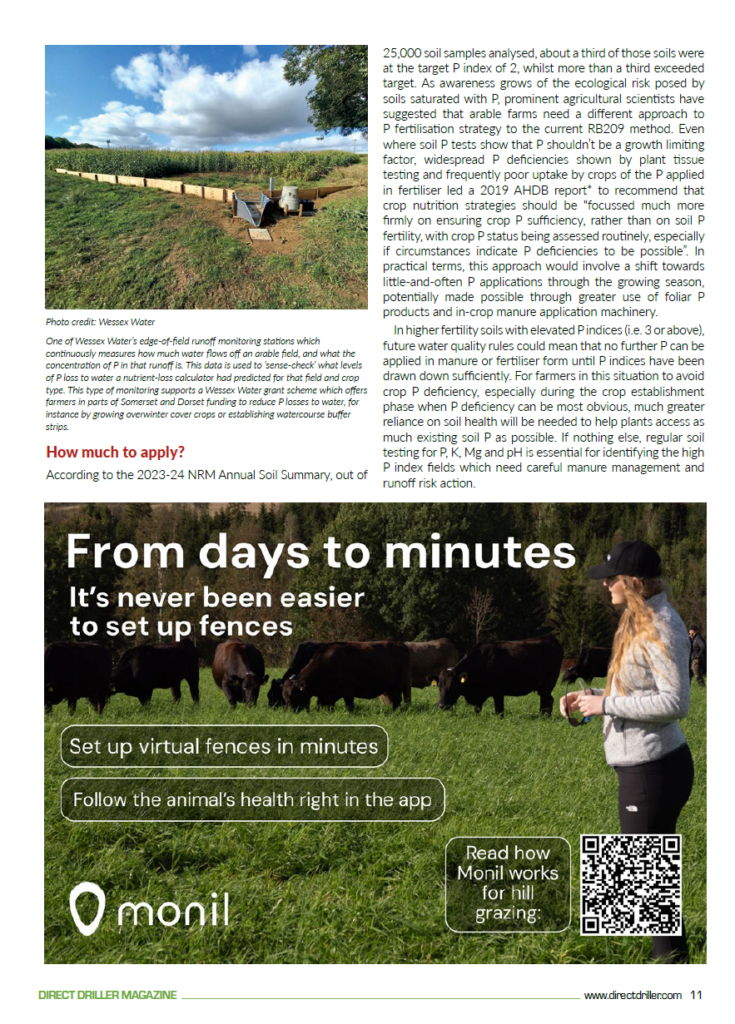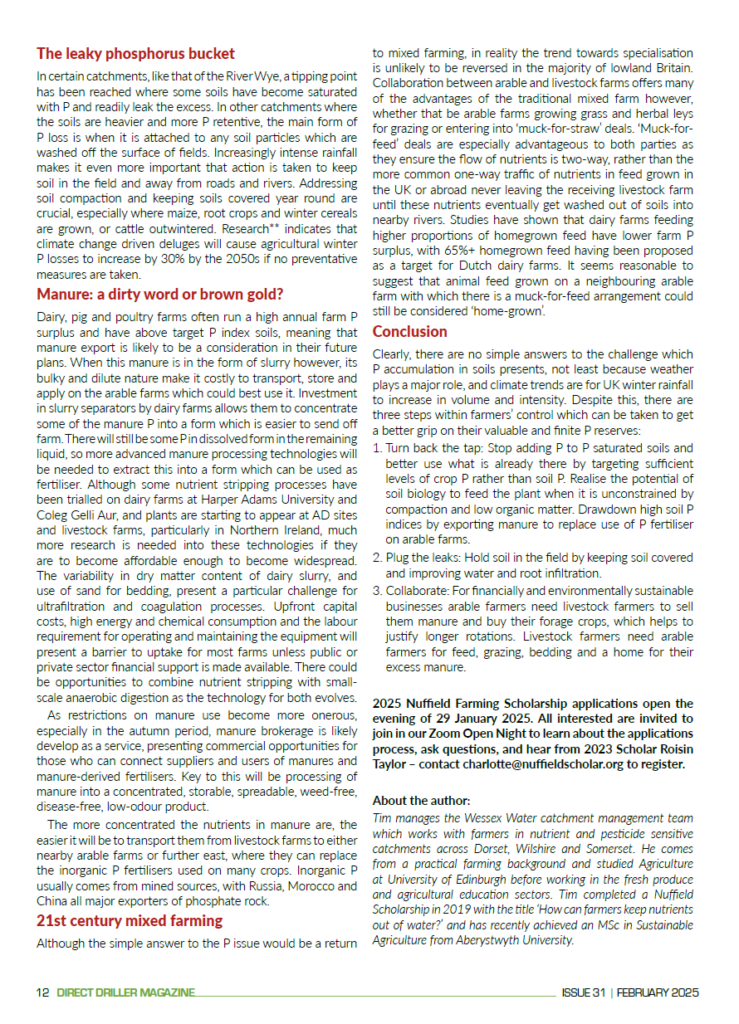Written by Tim Stephens NSch, Catchment Management Specialist, Wessex Water
A vital element
Phosphorus (P) is essential for life in all its forms, but many UK rivers, lakes and wetlands suffer from an excess of this critical element. Too much P causes growth of algae and duckweed, which smothers aquatic life and starves the water of oxygen. Very little P is needed to turn water green; it is said that just one kilo of P is sufficient to grow 500 kg of algae!
The two main sources of excess P are treated wastewater (i.e. sewage) and agriculture, although road runoff and septic tanks can also make significant contributions to the problem. Levels of P in many rivers have fallen over the past two decades; mainly due to major investment in wastewater treatment processes. As water companies in nutrient sensitive areas install P stripping equipment at their wastewater treatment works, regulatory and public attention is increasingly turning to reducing agricultural P loading to watercourses. Repeated algal blooms in the River Wye and Lough Neagh have led to widespread criticism of intensive livestock farming for overapplication of manure and of arable farms for excessive soil erosion.
| How much P is lost from farmland? Farm P losses vary according to rainfall, soil type, soil drainage properties and farm type; ranging from under 0.25 kgP/ha on low input pasture based systems on free draining soils in low rainfall areas, right up to 2 kgP/ha on intensive livestock or arable farms on heavy soils with high rainfall. Nationally, legally binding targets set in the 2021 Environment Act require at least a 40% reduction in nitrogen, P and sediment pollution from agriculture into the water environment by 2038. Early indications are that any future targets which may be set by the Environment Agency in England could require more intensive systems in the most sensitive catchments to more than halve their current P losses. |
An unbalanced system
Determining the level of P losses by field and farm relies on nutrient loss calculators as measuring actual losses in runoff and drain flow requires costly edge-of-field monitoring installations. Calculating a farm P balance is usually more straightforward for farmers and advisors than estimating field P losses as it uses readily available farm data on P inputs (usually the amount of feed, fertiliser and livestock brought onto the farm in a year) and P outputs (e.g. how much meat, milk and grain were sold off the farm). Farm P balance is the difference between these inputs and outputs and a recent survey of Wessex farms showed a range of values from a -20 kgP/ha deficit on an arable farm with high P indices taking a P ‘holiday’, -2 kgP/ha on an organic beef and arable farm, through to more than 20 kgP/ha surplus for higher stocking rate dairy farms importing a lot of feed. An arable farm selling only grain and importing only enough P fertiliser to replace P exports in that grain had a surplus of zero, or in other words was ‘balanced’.
| Did you know? The pattern of agricultural P loss is often likened to a ‘jerky conveyor belt’ because of the way that each episode of heavy rainfall mobilises P held in soils by washing it downhill in soil erosion, as well as stirring up P held in watercourse sediments, washing it a bit further downstream each time. In higher P index soils, heavy rain also washes out P in dissolved form through field drains. |
In livestock-dense catchments, which cover most of the western half of the British Isles, many decades of annual P surplus has led to the accumulation of significant quantities of P in our soils. Although the majority of this P is unavailable for plant uptake, all of it has the potential for ecological harm if it is washed into water. For example, a southwest England dairy farm recently surveyed had soil total P stocks to 15 cm depth of nearly 2,000 kgP/ha, whilst the amount of potentially available P (Olsen-P) to the same depth was less than 1.5% of the total at <30 kgP/ha. This situation is common but might be alleviated by liming low pH soils, application of gypsum to heavier and high magnesium soils or use of compaction-busting machinery or plant roots. The potential for using soil biology to access unavailable P is gaining more attention, for example by harnessing the ability of mycorrhizal fungi to supply plant roots with P. Soil-applied P activators may also have a role in increasing P availability in soils.
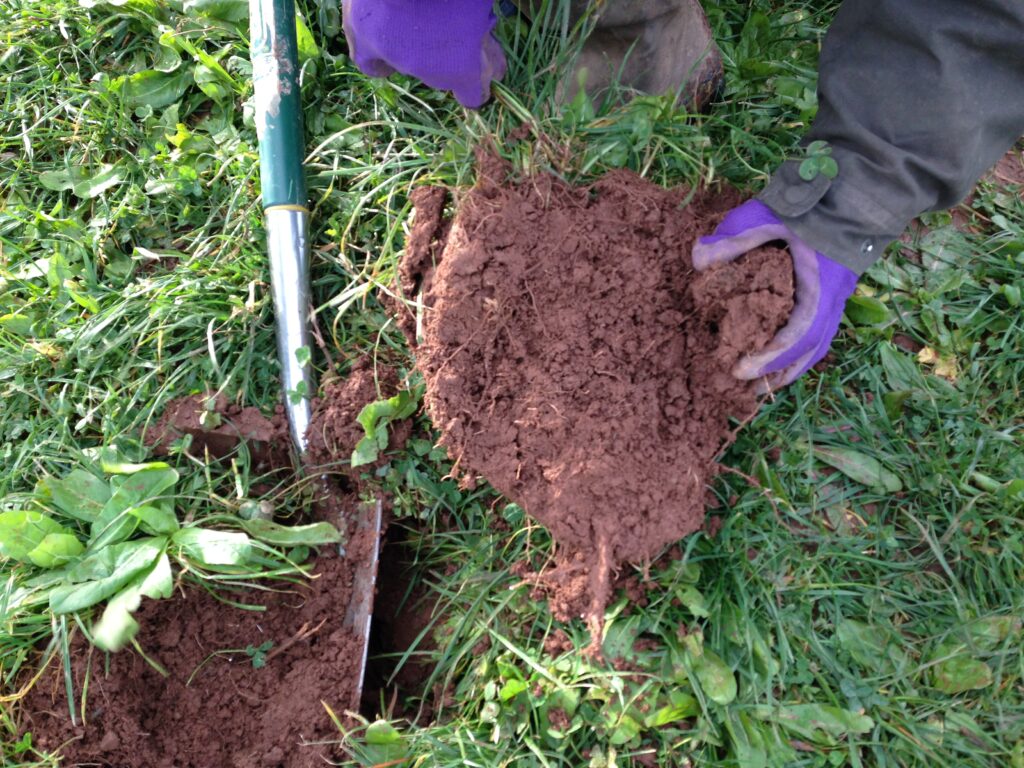
How much to apply?
According to the 2023-24 NRM Annual Soil Summary, out of 25,000 soil samples analysed, about a third of those soils were at the target P index of 2, whilst more than a third exceeded target. As awareness grows of the ecological risk posed by soils saturated with P, prominent agricultural scientists have suggested that arable farms need a different approach to P fertilisation strategy to the current RB209 method. Even where soil P tests show that P shouldn’t be a growth limiting factor, widespread P deficiencies shown by plant tissue testing and frequently poor uptake by crops of the P applied in fertiliser led a 2019 AHDB report* to recommend that crop nutrition strategies should be “focussed much more firmly on ensuring crop P sufficiency, rather than on soil P fertility, with crop P status being assessed routinely, especially if circumstances indicate P deficiencies to be possible”. In practical terms, this approach would involve a shift towards little-and-often P applications through the growing season, potentially made possible through greater use of foliar P products and in-crop manure application machinery.
In higher fertility soils with elevated P indices (i.e. 3 or above), future water quality rules could mean that no further P can be applied in manure or fertiliser form until P indices have been drawn down sufficiently. For farmers in this situation to avoid crop P deficiency, especially during the crop establishment phase when P deficiency can be most obvious, much greater reliance on soil health will be needed to help plants access as much existing soil P as possible. If nothing else, regular soil testing for P, K, Mg and pH is essential for identifying the high P index fields which need careful manure management and runoff risk action.
The leaky phosphorus bucket
In certain catchments, like that of the River Wye, a tipping point has been reached where some soils have become saturated with P and readily leak the excess. In other catchments where the soils are heavier and more P retentive, the main form of P loss is when it is attached to any soil particles which are washed off the surface of fields. Increasingly intense rainfall makes it even more important that action is taken to keep soil in the field and away from roads and rivers. Addressing soil compaction and keeping soils covered year round are crucial, especially where maize, root crops and winter cereals are grown, or cattle outwintered. Research** indicates that climate change driven deluges will cause agricultural winter P losses to increase by 30% by the 2050s if no preventative measures are taken.
Manure: a dirty word or brown gold?
Dairy, pig and poultry farms often run a high annual farm P surplus and have above target P index soils, meaning that manure export is likely to be a consideration in their future plans. When this manure is in the form of slurry however, its bulky and dilute nature make it costly to transport, store and apply on the arable farms which could best use it. Investment in slurry separators by dairy farms allows them to concentrate some of the manure P into a form which is easier to send off farm. There will still be some P in dissolved form in the remaining liquid, so more advanced manure processing technologies will be needed to extract this into a form which can be used as fertiliser. Although some nutrient stripping processes have been trialled on dairy farms at Harper Adams University and Coleg Gelli Aur, and plants are starting to appear at AD sites and livestock farms, particularly in Northern Ireland, much more research is needed into these technologies if they are to become affordable enough to become widespread. The variability in dry matter content of dairy slurry, and use of sand for bedding, present a particular challenge for ultrafiltration and coagulation processes. Upfront capital costs, high energy and chemical consumption and the labour requirement for operating and maintaining the equipment will present a barrier to uptake for most farms unless public or private sector financial support is made available. There could be opportunities to combine nutrient stripping with small-scale anaerobic digestion as the technology for both evolves.
As restrictions on manure use become more onerous, especially in the autumn period, manure brokerage is likely develop as a service, presenting commercial opportunities for those who can connect suppliers and users of manures and manure-derived fertilisers. Key to this will be processing of manure into a concentrated, storable, spreadable, weed-free, disease-free, low-odour product.
The more concentrated the nutrients in manure are, the easier it will be to transport them from livestock farms to either nearby arable farms or further east, where they can replace the inorganic P fertilisers used on many crops. Inorganic P usually comes from mined sources, with Russia, Morocco and China all major exporters of phosphate rock.
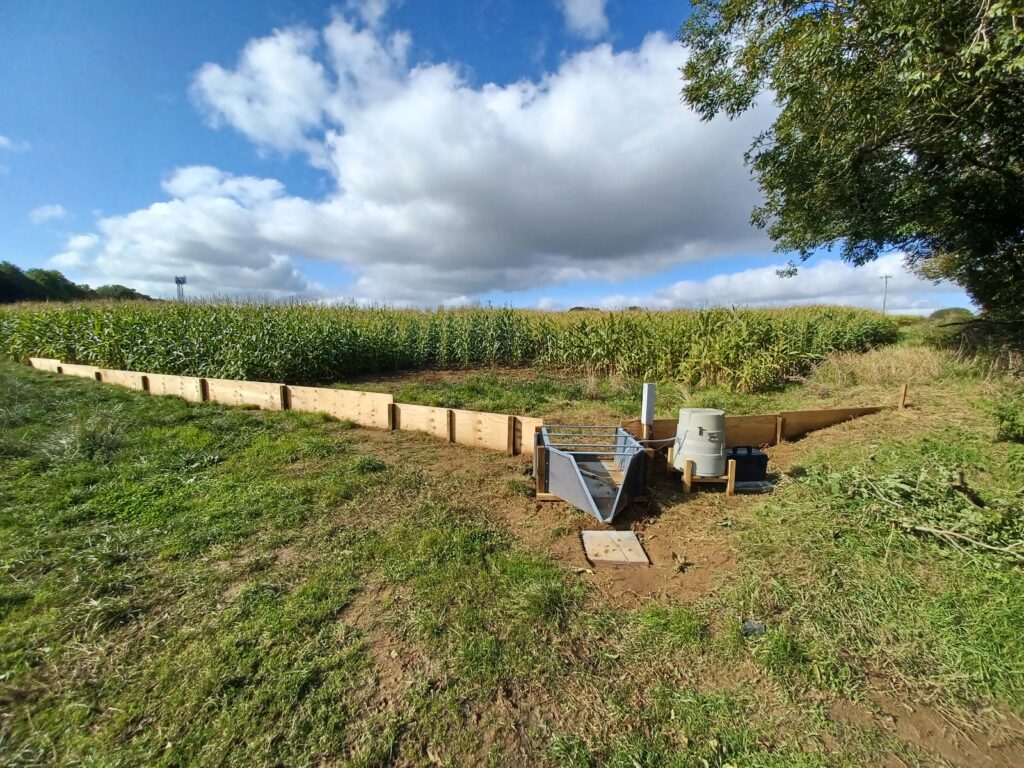
21st century mixed farming
Although the simple answer to the P issue would be a return to mixed farming, in reality the trend towards specialisation is unlikely to be reversed in the majority of lowland Britain. Collaboration between arable and livestock farms offers many of the advantages of the traditional mixed farm however, whether that be arable farms growing grass and herbal leys for grazing or entering into ‘muck-for-straw’ deals. ‘Muck-for-feed’ deals are especially advantageous to both parties as they ensure the flow of nutrients is two-way, rather than the more common one-way traffic of nutrients in feed grown in the UK or abroad never leaving the receiving livestock farm until these nutrients eventually get washed out of soils into nearby rivers. Studies have shown that dairy farms feeding higher proportions of homegrown feed have lower farm P surplus, with 65%+ homegrown feed having been proposed as a target for Dutch dairy farms. It seems reasonable to suggest that animal feed grown on a neighbouring arable farm with which there is a muck-for-feed arrangement could still be considered ‘home-grown’.
Conclusion
Clearly, there are no simple answers to the challenge which P accumulation in soils presents, not least because weather plays a major role, and climate trends are for UK winter rainfall to increase in volume and intensity. Despite this, there are three steps within farmers’ control which can be taken to get a better grip on their valuable and finite P reserves:
- Turn back the tap: Stop adding P to P saturated soils and better use what is already there by targeting sufficient levels of crop P rather than soil P. Realise the potential of soil biology to feed the plant when it is unconstrained by compaction and low organic matter. Drawdown high soil P indices by exporting manure to replace use of P fertiliser on arable farms.
- Plug the leaks: Hold soil in the field by keeping soil covered and improving water and root infiltration.
- Collaborate: For financially and environmentally sustainable businesses arable farmers need livestock farmers to sell them manure and buy their forage crops, which helps to justify longer rotations. Livestock farmers need arable farmers for feed, grazing, bedding and a home for their excess manure.
2025 Nuffield Farming Scholarship applications open the evening of 29 January 2025. All interested are invited to join in our Zoom Open Night to learn about the applications process, ask questions, and hear from 2023 Scholar Roisin Taylor – contact charlotte@nuffieldscholar.org to register.
References:
*AHDB Final Project Report: Cost-effective Phosphorus Management on UK Arable Farms by Sylvester-Bradley et al., March 2019.
**Nature Communications article: Major agricultural changes required to mitigate phosphorus losses under climate change by Ockenden et al., 2017.
About the author:
Tim manages the Wessex Water catchment management team which works with farmers in nutrient and pesticide sensitive catchments across Dorset, Wilshire and Somerset. He comes from a practical farming background and studied Agriculture at University of Edinburgh before working in the fresh produce and agricultural education sectors. Tim completed a Nuffield Scholarship in 2019 with the title ‘How can farmers keep nutrients out of water?’ and has recently achieved an MSc in Sustainable Agriculture from Aberystwyth University.
